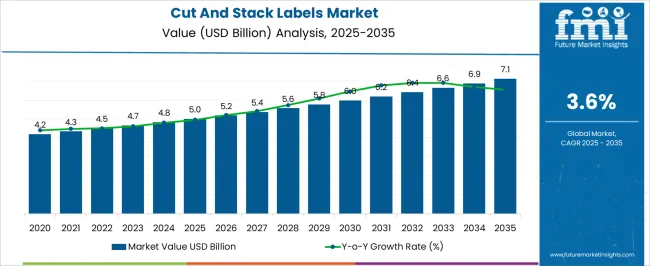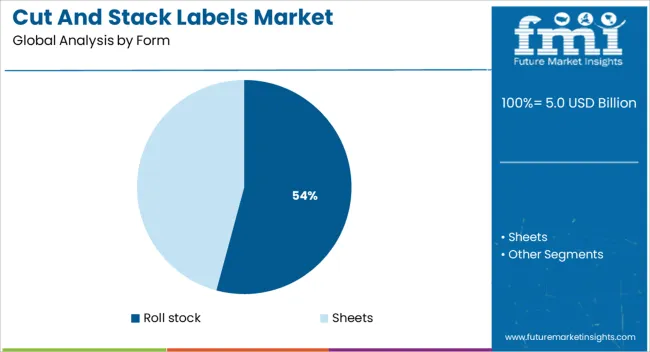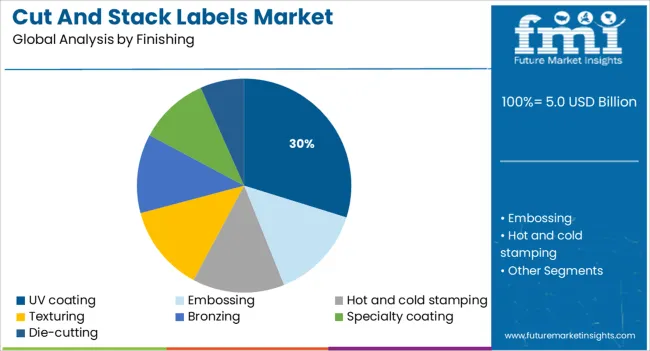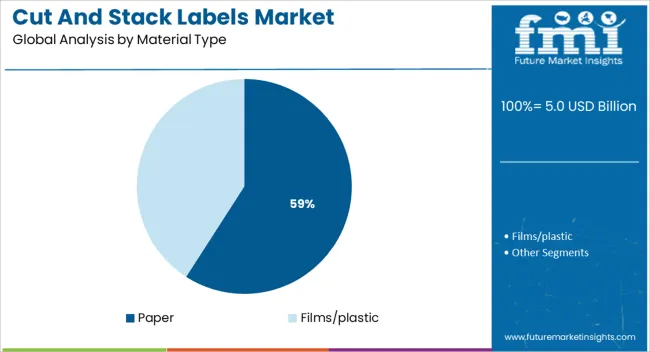The Cut And Stack Labels Market is estimated to be valued at USD 5.0 billion in 2025 and is projected to reach USD 7.1 billion by 2035, registering a compound annual growth rate (CAGR) of 3.6% over the forecast period.

| Metric | Value |
|---|---|
| Cut And Stack Labels Market Estimated Value in (2025E) | USD 5.0 billion |
| Cut And Stack Labels Market Forecast Value in (2035F) | USD 7.1 billion |
| Forecast CAGR (2025 to 2035) | 3.6% |
The Cut And Stack Labels market is witnessing steady growth, driven by its wide applicability in high-volume packaging environments and its compatibility with various substrates and printing technologies. Industries such as food and beverage, personal care, and home care continue to favor these labels due to their low production costs, fast application rates, and strong visual impact.
The growth in flexible packaging lines and continuous investments in labeling automation have further reinforced the relevance of cut and stack labels, particularly in emerging markets where cost sensitivity remains high. Technological advancements in offset and gravure printing have enabled high-definition print quality on a wide range of materials, while improvements in glue application methods have enhanced operational efficiency.
Sustainability trends have also begun to influence label design, encouraging greater adoption of recyclable materials and water-based coatings As product diversification increases and brand owners seek cost-optimized yet premium presentation formats, cut and stack labels are expected to maintain their foothold in mass-market packaging strategies.
The market is segmented by Form, Finishing, Material Type, and Promotional Type and region. By Form, the market is divided into Roll stock and Sheets. In terms of Finishing, the market is classified into UV coating, Embossing, Hot and cold stamping, Texturing, Bronzing, Specialty coating, and Die-cutting. Based on Material Type, the market is segmented into Paper and Films/plastic. By Promotional Type, the market is divided into Peel-N-reveal, Peel-N-reseal, Perforated coupon, and Digital personalization. Regionally, the market is classified into North America, Latin America, Western Europe, Eastern Europe, Balkan & Baltic Countries, Russia & Belarus, Central Asia, East Asia, South Asia & Pacific, and the Middle East & Africa.

The roll stock form segment is expected to hold 54.2% of the revenue share in the cut and stack labels market in 2025, making it the most dominant form type. The widespread adoption of roll stock labels is attributed to their compatibility with high-speed labeling equipment and their ability to reduce material waste during the production process.
Their continuous format allows for streamlined operation in large-scale manufacturing environments, especially in beverage and personal care sectors where rapid throughput is essential. Roll stock forms offer greater flexibility in label design and cutting configurations, enabling efficient changeovers without halting production lines.
Additionally, they support a wide variety of printing techniques including flexographic and digital, allowing brands to achieve high-quality graphics and custom finishes Their efficient storage and transport characteristics have further strengthened their position as the preferred choice for manufacturers seeking scalability, low cost per label, and minimal downtime in label application systems.

The UV coating segment is projected to account for 29.8% of the total revenue share in the cut and stack labels market in 2025. This segment's strong performance is supported by its ability to enhance visual appeal, improve abrasion resistance, and increase durability in high-moisture or high-contact environments.
UV coating allows for the application of a high-gloss or matte finish that not only improves shelf impact but also protects printed designs from smudging and fading during transportation or product handling. The finishing process does not require drying time, allowing for faster turnaround and higher throughput in label production.
Moreover, UV coatings are solvent-free and considered more environmentally friendly compared to traditional varnishes, aligning with sustainability goals adopted by many packaging companies As consumer brands continue to prioritize premium packaging appearance and long-term label integrity, UV coating is expected to remain a popular choice for enhancing both aesthetics and performance in competitive retail environments.

The paper material segment is forecast to contribute 59.1% of the overall revenue share in the cut and stack labels market in 2025, emerging as the most widely used material. The dominance of paper is attributed to its versatility, printability, and cost-efficiency, making it suitable for a broad spectrum of applications across food, beverage, and fast-moving consumer goods.
Paper-based labels provide excellent ink absorption and are compatible with a variety of finishing techniques including embossing and foil stamping, allowing for creative and high-impact packaging designs. Additionally, the availability of sustainable and recycled paper substrates has aligned this segment with the growing demand for environmentally conscious labeling solutions.
Regulatory pressures and brand commitments to reduce plastic usage have further supported the preference for paper materials With advances in paper coating technologies improving moisture resistance and surface strength, paper continues to offer an optimal balance between visual appeal, functional performance, and ecological responsibility.
Cut and stack labels are also known as wet glue labels or glue applied labels. Cut and stack labels are labels that are printed on roll feds or large sheets printing press. After printing the cut and stack labels are either cut into desirable shapes or more typically into individual rectangular shapes and stacked. The application of the cut and stack labels include overlapping the labels and then gluing the labels to itself.
Cut and stack labels are ideal for high volume application, because of the production process the cut and stack labels are cost effective and they are the most custom designed product labels in the labels market. These makes cut and stack labels cost effective even in large quantities.
Cut and stack labels are used on variety of products which are used by consumers for everyday use, some products are aluminum juice containers, aerosol cans, canned foods and other food and beverage needs.
Since the cut and stack labels are adaptable and durable makes them suitable for a variety of applications like cut and stack labels can be used on metal cans, glass bottles and jars. Cut and stack labels can be used for variety of market like food & beverage, paints and coatings, household products, automotive products, chemical products, pharmaceutical etc.
Cut and stack labels are driven by food and beverage industry as they are the most used forms of labels because they are most economical way to decorate variety of container of products. Cut and stack labels are economical even in large quantities. Cut and stack labels are even easy to customize because of which they can be used on any size or shape of products.
The popular look with beverage product labels is the clear and no color look, this can be achieved with same application process and traditional labeling equipment using cut and stack labels. The clear cut and stack labels are popular because they adhere quickly onto the packing.
Cut and stack labels are durable and they can with stand extreme temperatures, moisture and has even more properties due to variety of available materials. The key factors restraining the cut and stack labels is the available range of label types.
The substitutes of cut and stack labels are pressure sensitive labels, shrink sleeves, roll fed etc. Due to increase in technology and innovation the end users have realized the need for labels that are highly durable and easily readable hence they consider cut and stack labels.
Based on the geographies, the global cut and stack labels market is fragmented into seven key regions- Latin America, North America, Eastern Europe, and Western Europe, Middle East & Africa, Asia-Pacific except Japan and Japan. Among the regions mentioned above, Asia-pacific region has the highest growth rate followed by north America and will continue to be have a high attractiveness for the forecasted period.
The growth of cut and stack labels market share will be boosted in the Eastern Europe and Western Europe and Latin America for the forecast period with increase in adoption of small-sized PET bottles ranging from carbonated soft drinks to toiletries and cosmetic. Overall the market for cut and stack labels has a positive growth owning to the increasing use of the cut and stack labels in cosmetic and paints and coating industry.
Some of the market players identified in the global cut and stack labels market includes:
The research report presents a comprehensive assessment of the market and contains thoughtful insights, facts, historical data, and statistically supported and industry-validated market data. It also contains projections using a suitable set of assumptions and methodologies. The research report provides analysis and information according to categories such as market segments, geographies, type of product and applications.
The global cut and stack labels market is estimated to be valued at USD 5.0 billion in 2025.
The market size for the cut and stack labels market is projected to reach USD 7.1 billion by 2035.
The cut and stack labels market is expected to grow at a 3.6% CAGR between 2025 and 2035.
The key product types in cut and stack labels market are roll stock and sheets.
In terms of finishing, uv coating segment to command 29.8% share in the cut and stack labels market in 2025.






Our Research Products

The "Full Research Suite" delivers actionable market intel, deep dives on markets or technologies, so clients act faster, cut risk, and unlock growth.

The Leaderboard benchmarks and ranks top vendors, classifying them as Established Leaders, Leading Challengers, or Disruptors & Challengers.

Locates where complements amplify value and substitutes erode it, forecasting net impact by horizon

We deliver granular, decision-grade intel: market sizing, 5-year forecasts, pricing, adoption, usage, revenue, and operational KPIs—plus competitor tracking, regulation, and value chains—across 60 countries broadly.

Spot the shifts before they hit your P&L. We track inflection points, adoption curves, pricing moves, and ecosystem plays to show where demand is heading, why it is changing, and what to do next across high-growth markets and disruptive tech

Real-time reads of user behavior. We track shifting priorities, perceptions of today’s and next-gen services, and provider experience, then pace how fast tech moves from trial to adoption, blending buyer, consumer, and channel inputs with social signals (#WhySwitch, #UX).

Partner with our analyst team to build a custom report designed around your business priorities. From analysing market trends to assessing competitors or crafting bespoke datasets, we tailor insights to your needs.
Supplier Intelligence
Discovery & Profiling
Capacity & Footprint
Performance & Risk
Compliance & Governance
Commercial Readiness
Who Supplies Whom
Scorecards & Shortlists
Playbooks & Docs
Category Intelligence
Definition & Scope
Demand & Use Cases
Cost Drivers
Market Structure
Supply Chain Map
Trade & Policy
Operating Norms
Deliverables
Buyer Intelligence
Account Basics
Spend & Scope
Procurement Model
Vendor Requirements
Terms & Policies
Entry Strategy
Pain Points & Triggers
Outputs
Pricing Analysis
Benchmarks
Trends
Should-Cost
Indexation
Landed Cost
Commercial Terms
Deliverables
Brand Analysis
Positioning & Value Prop
Share & Presence
Customer Evidence
Go-to-Market
Digital & Reputation
Compliance & Trust
KPIs & Gaps
Outputs
Full Research Suite comprises of:
Market outlook & trends analysis
Interviews & case studies
Strategic recommendations
Vendor profiles & capabilities analysis
5-year forecasts
8 regions and 60+ country-level data splits
Market segment data splits
12 months of continuous data updates
DELIVERED AS:
PDF EXCEL ONLINE
Market Share Distribution Among Cut and Stack Labels Providers
Cutting Tool Packaging Market Size and Share Forecast Outlook 2025 to 2035
Cutting Boards Market Size and Share Forecast Outlook 2025 to 2035
Cut Flower Market Analysis - Size, Share, and Forecast Outlook for 2025 to 2035
Cutting Balloons Market Insights – Growth, Demand & Forecast 2025 to 2035
Cutting Fluid Market Growth – Trends & Forecast 2025-2035
Cutter Box Films Market Growth – Demand & Trends Forecast 2025-2035
Cutlery Market Growth – Trends & Demand Forecast 2025-2035
Industry Share Analysis for Cut Flower Companies
Cutaneous T-cell Lymphoma (CTLC) Market
Cutter-Box Packaging Market
Cutaneous Radiation Injury Treatment Market
Cutting and Bending Machine Market Size and Share Forecast Outlook 2025 to 2035
Acute Kidney Injury Treatment Market Growth - Trends & Forecast 2025 to 2035
Acute Migraine Treatment Market Trends – Analysis & Forecast 2024-2034
Executive Coaching Certification Market Size and Share Forecast Outlook 2025 to 2035
Subcutaneous Implantable Defibrillator System Market Size and Share Forecast Outlook 2025 to 2035
Executive Education Program Market Size and Share Forecast Outlook 2025 to 2035
Subcutaneous Drug Delivery Market Size and Share Forecast Outlook 2025 to 2035
Percutaneous Electrical Nerve Stimulators Market Analysis - Size, Share, and Forecast Outlook 2025 to 2035

Thank you!
You will receive an email from our Business Development Manager. Please be sure to check your SPAM/JUNK folder too.
Chat With
MaRIA